UK Christmas carols: Where do they come from?
- Published
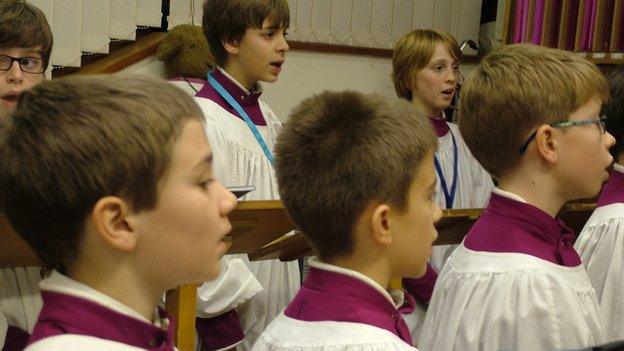
The words of the Coventry Carol have a darker subtext
Some of the UK's best known Christmas carols have long-standing associations with individual towns, villages and counties.
In churches, chapels and even pubs up and down the land, throats are being cleared and musical instruments tuned. Tis the season of the annual carol concert and in some of these communities, the same songs have been performed for centuries.
"Many towns and villages had their own distinctive repertoire of carols," said Professor Ian Russell from Aberdeen University, who has been studying the form since 1969.
Carols have been part of our festive tradition since the Middle Ages.
"Nowadays we use the word 'carol' to mean more or less any song connected to Christmas but originally 'to carole', meant 'to dance'," said BBC Radio 3 presenter Lucie Skeaping.
"By the late Middle Ages, the carol had become increasingly connected with the nativity story, featuring in plays, pageants and church processions."
Carols were also an important part of community entertainment. Some sprang out of drinking songs or folk tunes.
While the words of O Little Town In Bethlehem were written by an American clergyman, experts believe the tune was a folk melody collected by composer Vaughan Williams in 1903, in Forest Green, Surrey.
During the 19th Century many churches sought to replace the rumbustious Christmas sing-along with standardised hymns.

During the 19th Century many churches sought to standardise carols
"The carol was increasingly associated with the poor and illiterate," said Ms Skeaping. Were it not for folk music collectors, such as Williams and Cecil Sharp, who noted and published the songs they found, she believes the carolling tradition may have been lost forever.
While hundreds of carols have been lost from their communities, hundreds more, says Prof Russell, have been recorded and preserved.
Against all odds, then, in some communities - Cornwall, South Yorkshire and the Derbyshire Dales among them - a carolling tradition is alive and well.
In Derbyshire, Brian Woodall leads the Castleton Carollers, who sing every year around the community.
Carols many of us have never heard of, but which have been sung in Castleton for centuries, are given a rousing outing.
"Many of our carols were sung by the old lead miners years ago," he said. "We have kept the tradition going somehow."
This tradition, says Prof Russell, was not carolling led by Westminster organs and choirs in cassocks. "It was more about Thomas Clarke the shoemaker and John Hall the blacksmith creating music," he said. "And it's such wonderful, wonderful music."
So what other well-known works may have been left to us by the blacksmiths, shoemakers and their fellow craftsmen of times gone by?
The Coventry Carol
One of the most famous carols associated with a place is the Coventry Carol.
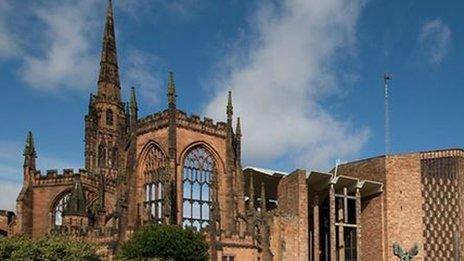
After the Blitz, the Coventry Carol was sung in the ruins of its cathedral
Ms Skeaping said the carol was sung in one of the medieval mystery plays performed in the city each year on the feast of Corpus Christi - the pageant of the shearmen and tailors.
The Coventry Carol
"The plays are first referred to in 1392, with the earliest-known manuscript dating from 1534," she said.
Like many traditional carols, the words have a darker subtext.
"The so-called 'Coventry Carol' comes near the very end of the play, at a highly dramatic moment when the women rock their babes to sleep for fear Herod's soldier will hear them crying and slaughter them," she said.
In Coventry, the carol is sung annually at the cathedral.
"For me, the really special thing about the Coventry Carol is the way it was used in 1940," said David Stone, the canon precentor.
"The cathedral was bombed on 14 November, and on Christmas Day that year the then provost broadcast live on the BBC to the world. His very famous message was that he was trying to forgive those who had done this terrible thing.
"After that, the choir sang the Coventry Carol in the ruins of the old cathedral."
He said the "shadowy" subject matter of the carol made it a particularly appropriate one for Coventry.
"The theme of redemption following suffering is part of the Coventry story," he said. And this is part, he added, of what makes the carol so special.
"It connects with people's lives as they really are," he said. "Even though some of the words are a bit peculiar, they strike a chord with people today and express what Christmas is for us, both its bright, shining side and its shadowy side."
I Saw Three Ships
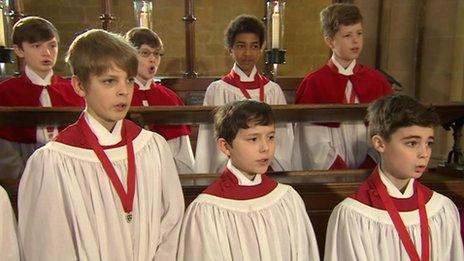
I Saw Three Ships is now a popular choice with church choirs but it probably originated as a folk song
A version of this song was apparently collected - appropriately enough - from a boatman on the Humber in 1895.
I Saw Three Ships
Ms Skeaping describes it as, "a carol with a long and strange pedigree".
"'I Saw Three Ships' has always seemed rather an innocent simple song, but originally it contained a verse which said that each of the three ships carried the skulls of the three wise men," she said.
The Sussex Carol
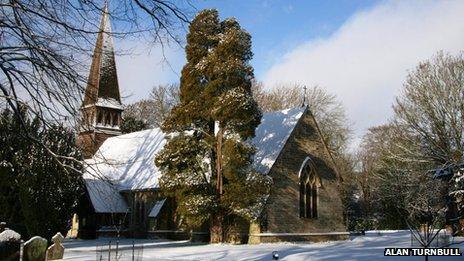
The Sussex Carol is still sung every year in the parish where it was found
The Sussex Carol is one example of a popular song that may not have been known to us had it not been for the early 20th Century wave of carol collectors.
The Sussex Carol
According to Susan Hempstead, who sings in the choir at St Andrew's Church, in Nuthurst, the composer Vaughan Williams overheard it being sung by a Mrs Verrall from the nearby village of Monk's Gate in 1904.
"Nowadays, it appears in quite a lot of Christmas carol books," she said.
The carol is still sung every year by the choir at the church.
"It's very much celebrated in our parish," added Mrs Hempstead. "There's been a choir at the church for more than 100 years and it's one we have sung for a long time.
"It's got a lively tune and it's good to keep the tradition going."
Deck The Hall With Boughs Of Holly
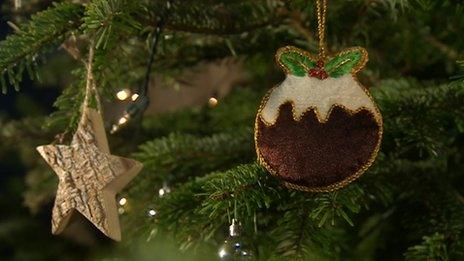
Deck The Hall was originally associated with new year, not Christmas
Deck The Hall With Boughs Of Holly
The tune of Deck The Hall is, in fact, that of a well-known Welsh carol, known as Nos Galan, which dates from the late 18th Century and which seems linked to new year, rather than Christmas, celebrations.
"There is a wonderful tradition of Welsh carolling, known as the plygain style," said Prof Russell. "It is still very active within Wales, particularly near Welshpool, and is connected to the Welsh language tradition.
Sans Day Carol
Like the Coventry Carol and the Sussex Carol, the Sans Day Carol is named after a place - the village of St Day in Cornwall.
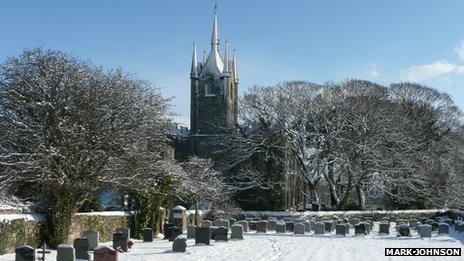
The Sans Day Carol is still performed in its namesake village St Day
Prior to the carol's publication in the Oxford Book of Carols, its name was changed from St Day Carol to Sans Day Carol.
The Sans Day Carol
Now the villagers of St Day want its rightful name restored.
"I would really love to start a campaign to get its name back," said Bernadette Fallon, who chairs the St Day Historical and Conservation Society.
"By rights it is the St Day Carol and it belongs to our village. It was first collected from a man named Thomas Beard, whose descendents still live in the village."
Ms Fallon said the carol is still sung annually in the village's church, chapel and market square.
"Any time there is a gathering of people from St Day, it's the first choice," she said
According to Ms Skeaping, the carol describes the ancient tradition of decorating the home with evergreens during midwinter.
The Holly And The Ivy
"There's no doubt this is a very old carol," said Prof. "A lot of people connect it with medieval carolling."
The Holly And The Ivy
The best-known tune was taken down in Gloucestershire by Cecil Sharp in 1911.
However, Prof Russell said a second melody was recorded from a traveller called Jones in the Forest of Dean.
"It's a lovely setting and one that has caught on in South Yorkshire," he said.

Exactly where many carols originated is, say experts, very difficult to determine
Despite the strong associations between carols and communities, in many cases it is difficult to trace the music's exact origin.
Jeremy Summerly, from the Royal College of Music, is presenting a Radio 4 series on the history of carols. He said some may simply be known by the place name where they were recorded, rather than where they originated.
"A good analogy is with football chants," he said. "If one group of fans adopts a song, they make it theirs and they become fiercely proud of it - but it may not actually have originated with them."
But, importantly, he added: "Where a carol has originated becomes almost irrelevant. The interesting thing is where they have taken root and are being performed today."
- Published7 December 2013